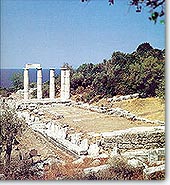



   | |
|
Some mystery cults had a restricted local character and took place in sanctuaries of families, gene or orgeones. The mysteries that occurred in the sanctuary of the Lykomidai family were known until late antiquity. The most celebrated offspring of that family was Themistokles. They were related to the "Great Goddess", who was usually identified with the Earth. It was said that the hymns of the rituals were composed by Orpheus, Musaios and Pamphos. From the little evidence that we have, we can only assume that it was a cult that involved cosmogonic issues with forms of sexuality and fertility. Other mysteries of local character were those practised in Lykosoura in honour of Despoina, in Idaion Andron for the nocturnal Zagreus, the Mothe of the Mountains and the Kouretes and in Andania of Messana for the Great Gods and Hagne. Most of the above mentioned mystery deities remain vague, since the ancient writers were always frugal in their references to them.
 | The sanctuary of Samothrace pre-existed the Archaic period, but its restructuring programme is related to Hellenistic colonization during the |
|
| |
|
Note: Click on picture for short description. | |